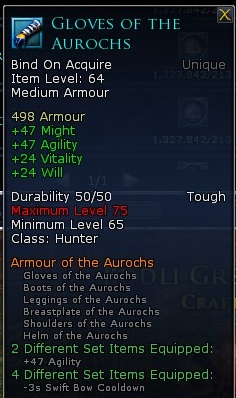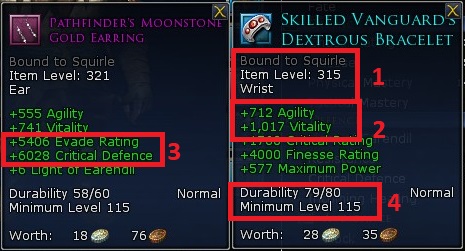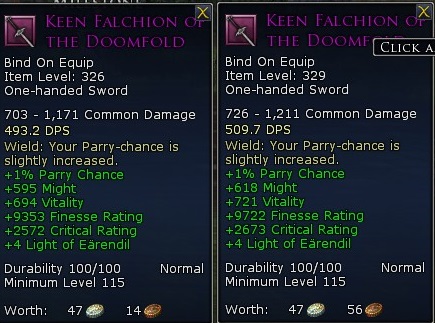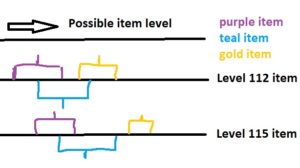Every bit of armour, weapon or jewelry your character is wearing was made by the game at one point. But how does the game decide what an item will look like and what stats it will have? For this article I’ll ignore your legendary items since these use a wildly different system, but nearly every other item you can equip is made in 2 different ways.
The two ways
The two ways i’m talking about arn’t crafted or granted by a GM. The two ways i mean are the ways the game has to decide what the item will be. An item can be completely fixed in its stats or it can vary in the numbers. Normally any item with a set bonus is a fixed item as is any item that you can barter. This has been the system for the early part of lotro. Later in the lifetime of lotro scaled instances were implemented where the amount of stats on amount was scaled towards the level of the recipient.
Fixed items
Not much to say about these items. Turbine and standing stone games decide what the item looks like, how much vitality and armour it will have and if the item has a set bonus. Everything on these items is fixed and can’t change. This requires every item to be designed, created and balanced. Normally this isn’t a problem, but as a game grows in size it becomes too much to maintain or retroactively change incase something changes.
Example of change
Each class now has vitality + 1 other main stat. These two are the ones you want the most and every class item will have these stats the most. This is why lots of old class items like the Auroch one still have strange stats. A hunter doesn’t really want like Might
Scaled items
Before we had a build your own item with the essences. The game had broken down the items in chunks. This way the game could award these items independent of your level. A level 20 can get the same item as a level 115. One will have a lot more stats than the other ofcourse. But this allowed them to scale the older instances like the Great barrow and Fornost. These days nearly every new instance can be scaled. Not everything scales as well as they might hope, but that’s for another article.
Scaled variables or how an item is build
Item quality (colour)
Once the game decides you will get an item it will decide what quality (colour) of item you will get. If everything remains the same a teal item will always be better than a purple. But there are plenty more parts that determine how good an item will be.
Minimum item level (4)
One of the first things it looks at is the level of the source (instance/mob) this will determine the minum level you can use it from. As you might expect. An item with a higher level will be better if the rest stays the same. On the other side, best is relative since you might have a level 112 teal item vs a level 115 purple item.
Basic and secondary stat packages (2) (3)
Scaled items are build up in two sets of stats. Basic stats are your vitality + agility and the secondary one is either an offensive or defensive package. The ratio of the basic stats can shift in offensive of defensive. But these will scale with the item level. Offensive packages will have more agility, finesse, crit rating etc and defensive packages will have more vitality, critical defence, mitigations etc.
Other packages, essence slots and light of earendil
There is a 3rd option that can have different stats like an essence slot, morale, light of earendil, audacity etc. But these will depend where you will get the item from. Being Mordor, the ettenmoors or other zones.
Item level: the heart of scaling (1)
Once the item quality, minimum item level, and stat packages are determined its time to actually scale the item for you. This misunderstood part is what decides how good an item is going to be. An item with item level 300 is always going to be better than the same item with item level 280. This used to be nearly invisible since you only had 1 option at that time in a drop or you could only get a fixed set item. But with the introduction of Mordor crafting and loot the item level has become pretty important. The left item is Ilvl 326 (no crit craft) and the right one is Ilvl 329 (crit craft). Minor differences that multiply across your gear. A few item levels would only mean 5 vitality, but this is now multiplied above level 105.
Interaction between item level, minimum level and quality
All 3 of these interact with each other in a way that not tangible. It’s possible to have a higher Ilvl purple that is better than a lower Ilvl teal item. Or a level 115 item that is worse than a 112. This can be confusing, but its easier to understand then you might think.
The item level will always determine how high a number can be. But the item colour/quality and minimum item level all have a possible ranges of item levels they could get.
This it the reason a teal item is better than a purple item or a 115 item better than a 112. It’s when they interact where a a special combination means an item is out of balance. For example the raid rewards get an extra boost in item level or a special quest item gets a boost. Resulting in a higher item level then it normally shouldn’t be able to get. These items behave like a scaled item, but Turbine/SSG intervened and made them better to be special like in the case of the allegiance cloak or Blessing of the Valar gear.
Appendix: scaling and the next article
Scaling is a way for developers to apply 1 set of rules across a wide range of flexible fields. A deck of cards is always 52 cards and the chances are always fixed, but in a game like lotro there are too many differences to apply 1 set of rules. To create the possibility to make content apply to all levels or vice versa make all levels fight the same mob you need to bend the rules or make them flexible.
This is what scaling is at heart. A way to make the loot, defensive or mob rules flexible. Make it able to have a player with a 30 card deck play the same game as one with a 70 card deck. If this is done well it gives you more players to play with. If the balance is off, the cards will be stacked against one person. That person being you or the challenge you’re expecting.







Recent Comments